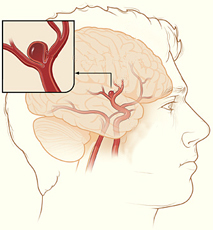 |
 |
 |
||
    |
||||
|
||||
|
Other Health Topics:
Brain Aneurysm
Also called: Berry aneurysm, Cerebral aneurysm, Intracranial aneurysm
A brain aneurysm is an abnormal bulge or "ballooning" in the wall of an artery in the brain. They are sometimes called berry aneurysms because they are often the size of a small berry. Most brain aneurysms produce no symptoms until they become large, begin to leak blood, or rupture. If a brain aneurysm presses on nerves in your brain, it can cause signs and symptoms. These can include:
Treatment depends on the size and location of the aneurysm, whether it is infected, and whether it has ruptured. If a brain aneurysm ruptures, symptoms can include a sudden, severe headache, nausea and vomiting, stiff neck, loss of consciousness, and signs of a stroke. Any of these symptoms require immediate medical attention. National Heart, Lung, and Blood Institute
Start Here
|
| Home | Health Topics | Drugs & Supplements | Encyclopedia | Dictionary | News | Directories | Other Resources | |
| Disclaimers | Copyright | Privacy | Accessibility | Quality Guidelines U.S. National Library of Medicine, 8600 Rockville Pike, Bethesda, MD 20894 National Institutes of Health | Department of Health & Human Services |
Date last updated: 04 March 2009 Topic last reviewed: 02 March 2009 |


